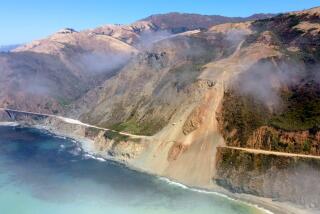Quake Road Rebuilding Put at $1.5 Billion : Highways: Caltrans warns local governments they may have to fend for themselves. Plan outlined to compensate Nimitz Freeway victims.
- Share via
OAKLAND — Caltrans Director Robert K. Best on Wednesday said it will cost about $1.5 billion to rebuild state and local roads damaged in the Bay Area earthquake and outlined a proposal to compensate victims of the Nimitz Freeway collapse.
Best, testifying before a special hearing of the state Senate Transportation Committee, said the federal government will cover at least half and probably more of the state’s rebuilding expenses.
The rest will have to be paid by California taxpayers, either through a temporary sales tax increase to be considered by the Legislature today or out of funds already earmarked for highway construction statewide.
Local governments, which will be faced with an estimated $300-million-to-$500-million road repair bill from the earthquake, may have to fend largely for themselves, he said.
Best said it will also cost the state between $300 million and $500 million to complete a program to enable every state highway to withstand the strongest earthquake imaginable.
It is crucial, Best said, for the state to move quickly to spend the emergency federal aid because any funds spent in the next six months will not have to be matched by the state. He asked the lawmakers to pass legislation that would waive laws and regulations that can delay the design and construction of freeway projects.
That request was opposed by the Sierra Club and the city of Oakland. But Best promised that Caltrans would not abuse that authority if it is granted.
“If we are allowed to expedite, that doesn’t mean we are going to slap on the blinders and put our heads and noses down to the center line and just roar,” Best said. “We will be going through a type of process that involves the local governments, involving environmental groups and other interest groups that legitimately have something to be said.”
In other comments to the committee, Best gave the first details of the Deukmejian Administration’s proposal to offer victims of the Nimitz Freeway collapse compensation outside of the courts’ civil liability system.
He said the survivors and the heirs of those killed should be given the choice of suing the state or applying for payments through a simplified claims system that could include arbitration.
Best did not concede that the state would be legally liable for the collapse. He said the courts found the state not responsible for the deaths of two people killed in the collapse of a bridge in the 1971 Sylmar earthquake in the San Fernando Valley.
But Sen. Bill Lockyer (D-Hayward), chairman of the Senate Judiciary Committee, said he believed that the disaster could cost the state “hundreds of millions of dollars” in legal judgments or settlements.
Lockyer said the state would have a “very weak defense, if anything at all,” if it is sued for the deaths and injuries on the Nimitz.
To keep the matter out of the courts, Best said the Deukmejian Administration will ask the Legislature to enact the special reimbursement system, which would be aimed at providing quick payments without the need for lawyers, who often collect 30% or more of court-awarded liability judgments.
“What we are dealing with here is not a liability question but earthquake relief,” Best said. “Otherwise, you are dealing with people who may have suffered very severe personal damages and the only mechanism open to them would be the very arduous, time-consuming and, to some degree, uncertain tort recovery system.”
Best said he envisions a program under which the state would compensate victims immediately for minor costs, such as the replacement of damaged vehicles or lost income. Larger claims would be deferred for a short time and settled through an arbitration process.
Providing quick and easy settlements for victims, Best said, would be “more important than providing an open-ended liability scheme for people to try to take advantage of.”
In the Oct. 17 earthquake, with a 7.1 magnitude, the upper deck of the Nimitz Freeway collapsed onto the lower roadway. Officials now say that 41 people died in the collapse.
Engineers have offered a number of theories for the freeway’s collapse, but the leading explanation centers around failure of joints connecting the upper and lower columns.
More to Read
Sign up for Essential California
The most important California stories and recommendations in your inbox every morning.
You may occasionally receive promotional content from the Los Angeles Times.










